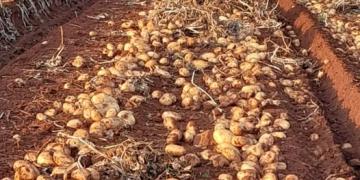China: The potato, a vital component of the country’s agricultural strategy.
Far from being just a complementary vegetable, the tuber has become a staple food, driven by an ambitious government policy and significant investment in technology.

This article, based on a detailed analysis of Lukie Pieterse’s Potato News Today report "Beyond Rice and Wheat," explores how this transformation affects the global landscape and sets new standards for modern agriculture.
Potatoes, a pillar of Chinese food security.
The change in the status of the potato in China was not organic, but rather the result of a deliberate political decision. The Chinese government recognized its versatility, resilience, and high yield potential compared to traditional grains like rice and wheat.
The turning point came in 2015, when China launched the "Potato as a Staple Food" strategy. This initiative aimed to diversify the country’s food mix and reduce its dependence on cereals by making better use of arable land, given that potatoes produce more food per unit area.
See moreAdvertising on ArgenpapaEconomic news about potatoesOnion pricesCertified potato seedsGardening toolsQuote historyCooking recipes with potatoesPotato harvesting equipmentEfficient irrigation systemsInsurance for agricultural cropsThis policy generated significant investments in research, development, subsidies for farmers, and processing infrastructure. The result solidified China’s position as the world’s largest producer, with an annual output exceeding 90 million tons.
Technological advancement: from the field to processing.
The modernization of potato production in China is driven by intensive technological innovation, which has increased productivity and efficiency throughout the supply chain. Significant efforts have been dedicated to seed and variety technology. Chinese research institutions have invested in developing new potatoes that are more resistant to diseases, pests, and environmental stressors such as heat and drought. Research is underway on late blight-resistant varieties, biofortification to increase vitamin and mineral content, and the development of varieties with a lower glycemic index.
Furthermore, the use of digital technology is ubiquitous in Chinese production. Precision agriculture utilizes advanced tools such as drones (UAVs) for crop monitoring, pest control, and irrigation management. GPS and satellite imagery provide real-time data on soil and crop health. The use of Big Data and analytics optimizes operations, predicts risks, and maximizes production.
The complete mechanization of the planting, harvesting, and processing stages has also been crucial in reducing losses and labor costs. This, in turn, has fueled the growth of the processed food market. China has significantly expanded its production of frozen pre-fried products, potato chips, starches and flakes, as well as potato flour as an alternative to wheat flour. This value-added strengthening of the supply chain and generating new revenue opportunities.
Global exports and sustainability challenges
China’s reach extends beyond domestic consumption, positioning it as a key player in the international potato trade. The country exports fresh and processed products to Southeast Asia, the Middle East, and Africa. The government supports this expansion through trade agreements and investments in port infrastructure and advanced traceability systems, such as blockchain.
See morePest control suppliesFertilizers for papayaSolanum tuberosumArgenpapa newsletter subscriptionOnline advertisingInternational prices of potatoesLo Valledor Market AnalysisCertified potato seedsPope InformationOnion pricesHowever, the rapid growth of the industry poses serious environmental challenges that must be managed to achieve long-term sustainability. The main risks include soil degradation, water scarcity due to intensive water use in arid regions, and the overuse of chemicals, which leads to water and soil pollution.
In response, the country has promoted initiatives such as crop rotation, integrated pest management (IPM), and the adoption of highly efficient irrigation systems, such as drip irrigation, seeking a necessary balance between production and environmental responsibility.
A look to the future
In China, the potato is more than just a commodity: it represents a model of innovation, resilience, and strategic agricultural policy. The future of the industry will be shaped by the continued digitalization of agriculture and an even greater focus on environmental sustainability. By balancing the need for high production with the responsible management of resources, China is not only ensuring its food security but also solidifying its position as a leader that will influence technological and quality standards in the global potato market.
Fuente: abbin.org




